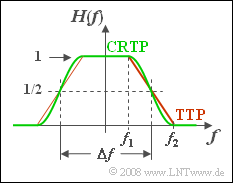Difference between revisions of "Aufgaben:Exercise 1.8: Variable Edge Steepness"
| Line 99: | Line 99: | ||
'''(4)''' <u>Suggestions 1, 2 and 4</u> are correct here: | '''(4)''' <u>Suggestions 1, 2 and 4</u> are correct here: | ||
| − | *The impulse response $h_{\rm CRTP}(t)$ of the raised-cosine low-pass filter also has zeros at an interval of $\Delta t$ due to the | + | *The impulse response $h_{\rm CRTP}(t)$ of the raised-cosine low-pass filter also has zeros at an interval of $\Delta t$ due to the sinc–function. |
*The cosine function has zeros at the following times: | *The cosine function has zeros at the following times: | ||
:$${\cos(\pi \cdot r \cdot {t}/{ \Delta t} )} = 0 \hspace{0.3cm}\Rightarrow \hspace{0.3cm}r \cdot {t}/{ \Delta t} = \pm | :$${\cos(\pi \cdot r \cdot {t}/{ \Delta t} )} = 0 \hspace{0.3cm}\Rightarrow \hspace{0.3cm}r \cdot {t}/{ \Delta t} = \pm | ||
Revision as of 16:05, 8 September 2021
Two low-pass filters with variable edge steepnesses are compared with each other. For frequencies $|f| ≤ f_1$ , $H(f) = 1$ holds in both cases. In contrast, all frequencies $|f| ≥ f_2$ are suppressed entirely.
In the range $f_1 ≤ |f| ≤ f_2$ the frequency responses are defined by the following equations:
- Trapezoidal low-pass filter (TTP):
- $$H(f) = \frac{f_2 - |f|}{f_2 - f_1} ,$$
- Raised-cosine low-pass filter (CRTP):
- $$H(f) = \cos^2 \left(\frac{|f|- f_1}{f_2 - f_1} \cdot\frac{\pi}{2} \right).$$
Alternative system parameters for both low-pass filters are
- the equivalent bandwidth $Δf$ defined by the equal-area rectangle, and also
- the roll-off factor (in frequency domain):
- $$r=\frac{f_2 - f_1}{f_2 + f_1} .$$
Throughout the task, $Δf = 10 \ \rm kHz$ and $r = 0.2$ hold true.
The impulse responses are with the equivalent impulse duration $Δt = 1/Δf = 0.1 \ \rm ms$:
- $$h_{\rm TTP}(t) = \frac{1}{\Delta t} \cdot {\rm si}(\pi \cdot \frac{t}{\Delta t} )\cdot {\rm si}(\pi \cdot r \cdot \frac{t}{\Delta t} ),$$
- $$h_{\rm CRTP}(t) = \frac{1}{\Delta t} \cdot {\rm si}(\pi \cdot \frac{t}{\Delta t} )\cdot \frac {\cos(\pi \cdot r \cdot t / \Delta t )}{1 - (2 \cdot r \cdot t/\Delta t )^2}.$$
Please note:
- The exercise belongs to the chapter Some Low-Pass Functions in Systems Theory.
- In particular, reference is made to the pages Trapezoidal low-pass filter and Raised-cosine low-pass filter.
- You can check your results with the interactive applet Frequency response and impulse respond .
Questions
Solution
- For both low-pass filters, the integral over $H(f)$ is equal to $f_1 + f_2$.
- Thus, due to $H(f = 0 = 1)$ Approach 2 is correct: $\Delta f = f_1 + f_2.$
(2) Substituting the relation found in (1) into the defining equation of the roll-off factor the following is obtained:
- $${f_2 - f_1} = r \cdot \Delta f = {2\,\rm kHz}, \hspace{0.5cm} {f_2 + f_1} = {10\,\rm kHz}.$$
- By addition or subtraction of both equations the so-called "corner frequencies" result in
- $$f_1 \underline{= 4 \ \rm kHz},$$
- $$f_2 \underline{= 6 \ \rm kHz}.$$
(3) Suggestions 1 and 4 are correct:
- The first $\rm sinc$–function of $h_{\rm TTP}(t)$ causes zeros at an interval of $\Delta t$ (see also the equation on the information page).
- The second $\rm sinc$–function causes zeros at multiples of $5 · \Delta t$.
- There are no additional zeros since these coincide exactly with the zeros of the first $\rm sinc$–function.
- The special case $r = 0$ corresponds to the ideal rectangular low-pass filter with $\rm sinc$–shaped impulse response. This decays extremely slowly.
- The $\rm si^2$–shaped impulse response of the triangular low-pass filter $($special case for $r = 1)$ decays asymptotically with $1/t^2$, i.e. faster than with $r = 0.2$.
(4) Suggestions 1, 2 and 4 are correct here:
- The impulse response $h_{\rm CRTP}(t)$ of the raised-cosine low-pass filter also has zeros at an interval of $\Delta t$ due to the sinc–function.
- The cosine function has zeros at the following times:
- $${\cos(\pi \cdot r \cdot {t}/{ \Delta t} )} = 0 \hspace{0.3cm}\Rightarrow \hspace{0.3cm}r \cdot {t}/{ \Delta t} = \pm 0.5, \pm 1.5, \pm 2.5, \text{...} \hspace{0.3cm} \Rightarrow \hspace{0.3cm} {t}/{ \Delta t} = \pm 2.5, \pm 7.5, \pm 12.5, ... $$
- $$\Rightarrow \hspace{0.3cm} {t}/{ \Delta t} = \pm 2.5, \pm 7.5, \pm 12.5, \text{...}. $$
- However, the zero of the numerator at $t / \Delta t = 2.5$ is nullified by the denominator which is also vanishing.
- By contrast, the other zeros at $7.5, 12.5,\text{...} $ remain.
- Here, $r = 0$ results in the rectangular low-pass filter and thus in the $\rm sinc$–shaped impulse response.
- In contrast, the impulse response of the cosine-square low-pass filter $($special case for $r = 1)$ decays extremely fast.
- This is studied in detail in Exercise 1.8Z .
